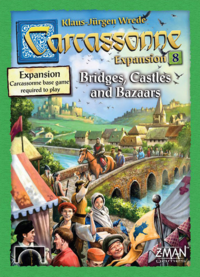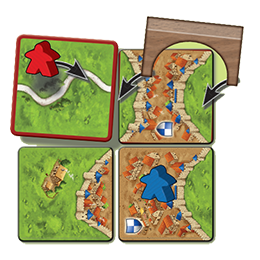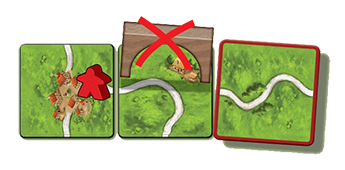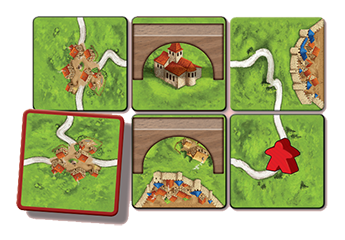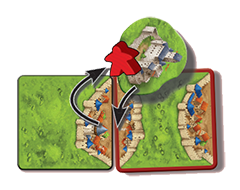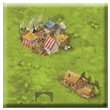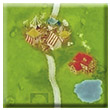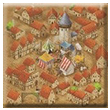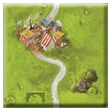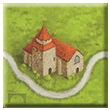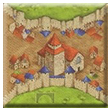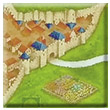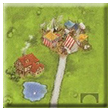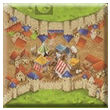Bridges, Castles and Bazaars
General info and comments
Bridges, Castles and Bazaars (originally Brücken, Burgen und Basare) was released for the New Edition by Hans im Glück in 2017. It is an update of the first edition released in 2010.
This is the eighth major expansion for Carcassonne and introduces some new aspects to the game. Travelling traders arrive in the land and organize bazaars, in which haggling is considered an art. At the same time, engineers are expanding the road network with modern bridges, and small castles are being built everywhere to defend the region.
New features/things are:
- Bridges
- Castles
- Bazaars
A Carcassonne expansion is not really a Carcassonne expansion when there are no new tiles, so in the box you also find 18 tiles that represent city segments, road segments and cloisters in new configurations plus the addition of bazaars which will help create much more than a beautiful landscape.
Contents
- 12 new land tiles including 8 with a bazaar
- File:Bridges Castles Bazaars C2 Feature Bazaar.pngBazaar symbol
- 12 castle token
- File:Bridges Castles Bazaars C2 Feature Castle.pngCastle token
- 12 wooden bridges
Rules
Preparation
Shuffle the new land tiles with those of the base game and stack them facedown as a general supply within easy reach of all players.
Then, give each player a number of bridges and castles:
- When playing with 2, 3, or 4 players, give each player 3 bridges and 3 castles.
- When playing with 5 or 6 players, give each player 2 bridges and 2 castles.
The twelve new land tiles should be mixed with those of the basic game. Over the course of play they will be drawn and placed according to the usual rules.
Bridges
1. Placing a tile
Just like in the base game, you must place tiles so that its edges match the edges of the tiles already in play. After placing a tile, you may [1] place a bridge, which counts as a road and connects roads over features or meeples on that tile. [2]
You can place one bridge on the tile you just placed, or on a tile touching the tile you just placed. When placing a bridge, you must place both ends in a field, and it must be placed facing either left-to-right or up-to-down (it cannot be placed diagonally across the tile). Once placed, a bridge remains on that tile until the end of the game.
You can place a tile so that a road ends against a field, but you must place a bridge that continues the road on that same turn. You can use multiple bridges in a row along the same road, but each tile can have a maximum of only one bridge on it. [3] Bridges can be placed on tiles with meeples on them.
2. Placing a meeple
After placing a tile, you can place a Meeple normally. If you build a bridge on the tile you just placed, you can place your meeple (or another figure) on the bridge as if it were a road.
3. Scoring a feature
Bridges are scored like tiles with a road on them. [4]
Bridges do not separate cities or fields.
Castles
3. Close a small city and place a castle
When you place a tile that completes a small city (a city consisting of only 2 tiles [5]), if a player has a meeple occupying that city, he or she chooses to either score 4 points as normal, or to place a castle on that small city instead. [6]
When you place a castle, cover the small city that was just completed with a castle from your supply.
Once placed, a castle remains on that tile until the end of the game. [7]
3. Scoring a castle
Placing a castle does not score you any points. Instead, you score points when a neigboring feature is completed. [8] A feature is considered neigboring if it is on either one of the 2 tiles containing your castle, the 2 tiles to the right, or the 2 tiles to the left.
Only part of the completed feature needs to be on a neighboring tile for you to score points for it. Both you and the player who would normally score points for that feature score its full points. [9] Once you score points for a neighboring feature, your meeple is returned to your supply, but your castle remains on its place until the end of the game.
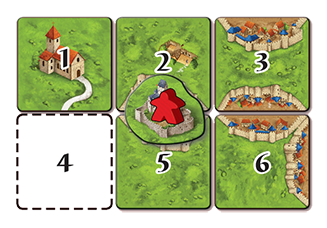
- The monastery on 1
- The road to 1
- The top city on 3
- The right city on 6
The following rules apply to castles:
- You must score points for the first feature completed on a tile neighboring your castle. You cannot forego scoring to leave your meeple for a later feature.
- Even if the first completed feature does not contain a meeple, you still score points from it if it is neighboring your castle. [10]
- If you control both a castle and the next completed neighboring feature, you score its points twice (once for the feature and once for the castle.)
- A monastery is only neighboring a castle if the tile with the monastery on it is in one of the 6 neighboring spaces.
- If a tile is placed that causes multiple features that are neighboring your castle to be completed at the same time, you decide what order they are scored. As always, you only score points for the first feature.
- If a castle is scored while neighboring your castle, your castle is also scored. All castles involved in such a scoring score points from the initial completed neighboring feature.
- Castles separate fields, just like roads or cities.
Final scoring
At the end of the game, an unscored castle is worth no points. When determining the value of a field, castles are worth 4 points (instead of 3.)
Bazaar
When you draw a tile with a bazaar on it, do the steps: 1. Place a tile, 2. Place a meeple and 3. Score a feature normally. You cannot place a meeple on the bazaar. [11]
Template:RulesCropCircleAction
Other expansions
This section contains additional information about the interactions with other Carcassonne expansions.
Bridges
- You can place the following figures on a bridge:
- Normal meeple, the standard option (Base game)
- Large meeple (Exp. 1 - Inns and Cathedrals)
- Builder (Exp. 2 - Traders and Builders)
- Wagon (Exp. 5 - Abbey & Mayor)
- Ringmaster (Exp. 10 - Under the Big Top)
- Phantom (The Phantom)
- Exp. 4 - The Tower: You can place a bridge and a tower on the same tile. If necessary, adjust the tower's position to make room for the bridge.
- Exp. 10 - Under the Big Top: You can place a bridge over the campground. You can only place a bridge on the acrobat tile if there is no acrobat on that tile.
Castles
- You can place the following figures in a castle:
- Normal meeple, the standard option (Base game)
- Large meeple (Exp. 1 - Inns and Cathedrals)
- Wagon (Exp. 5 - Abbey & Mayor)
- Mayor, however, since the castle doesn't have a coat of arms, the mayor cannot score points (Exp. 5 - Abbey & Mayor)
- Ringmaster (Exp. 10 - Under the Big Top)
- Phantom (The Phantom)
- When scoring a castle, you still score bonus points for:
- Roads with an inn (Exp. 1 - Inns and Cathedrals)
- Cities with a cathedral (Exp. 1 - Inns and Cathedrals)
- Monasteries or shrines with a vineyard (Exp. 9 - Hills & Sheep)
- Exp. 2 - Traders and Builders: When scoring fields with a pig, the castle is worth 5 points.
- Exp. 3 - The Princess and the Dragon: The dragon cannot eat meeples in the castle. You can place the fairy with a meeple in the castle and score the usual fairy points. [12]
- Exp. 4 - The Tower: A tower cannot capture any meeples in the castle.
- Exp. 5 - Abbey & Mayor: When scoring a field, whether for farmers or barns, a castle is worth 1 point more than a completed city.
- Exp. 6 - Count, King and Robber: A castle does not score as a completed city for the king.
- Exp. 10 - Under the Big Top: When scoring a circus, your meeple in the castle scores points if part of the castle lies within the circus' surroundings. For the purpose of scoring the castle, acrobat pyramids do not count as completed features.
- River II - River II: The pigsty (or pig-herd) tile provides one more point for castles in the field.
- Monasteries in Germany (New Edition) / Japanese Buildings or Monasteries in Germany (1st Edition) / Monasteries in The Netherlands & Belgium: Because an abbot scores only at the end of the game, and this monastery is never considered completed, a monastery with an abbot will not score points for a meeple in a castle.
- Besiegers - Cathars - Siege: A city under siege (or under attack from Cathars) can be converted to a castle, and it is handled as a normal castle. The siege or Cathar attack is ignored after conversion to a castle.
- The Wheel of Fortune: Castles do count for scoring of the Famine sector of , as this is effectively a scoring of farms. Followers from the City of Carcassonne cannot move to a castle.
- The Plague: Meeples in castles are safe from the plague, as it affects the tile directly, and castles are not present on a specific tile.
Bazaar
- Exp. 2 - Traders and Builders: If you place a bazaar tile and it expands [13] [14] a road or city containing your builder, complete the bazaar auction before beginning your double turn.
![]() Question: What is the order of events if the bazaar tile extends a feature with a builder?
Question: What is the order of events if the bazaar tile extends a feature with a builder?
If you draw a bazaar tile and can perform your builder-turn, first take the appropriate number of face-down tiles and perform the bazaar and the auction. Then a new round with a special property starts – each player has an open and known tile instead of drawing an unknown tile, and you cannot place your abbey as your first tile. If you placed your auctioned tile and you can perform a builder-turn, you can choose to place your abbey or draw a new unknown tile. If any player draws a new bazaar tile [for his or her builder-turn], it will be ignored until the last player who has an auctioned tile finishes his turn (including his builder-turn, if possible). Any pending delayed bazaars will take place now in turn. Once the bazaar rounds are finished, you perform your builder-turn.
In other words:
- Draw bazaar and perform first part of your double turn.
- ** // Start pending bazaars // **
- Draw the tiles (still face-down)
- Turn tiles face-up and perform the auction
- ( Start delaying any new bazaars )
- 1st Player with auctioned tile
- 1st player’s builder-turn, if applicable
- Next player with auctioned tile
- Next player’s builder-turn, if applicable
- ...
- Last player with auctioned tile
- Last player’s builder-turn, if applicable
- ( Stop delaying any new bazaars )
- Player who drew and placed a new bazaar in his/her builder turn (pending delayed bazaar)
- ** Back to // Start pending bazaars // until no pending delayed bazaars **
- Perform your builder-turn (second part of your double turn)
- Exp. 3 - The Princess and the Dragon: If you place a dragon tile during a bazaar auction, the dragon moves immediately before continuing the bazaar auction.
Tile distribution
Total Tiles: 12
Note: The initial tile distribution by in Germany presented the following differences by mistake: Tiles marked with (–) were missing and, instead, two copies were included of the tiles marked with (+).
Some of the tiles have a small illustration on them. The letters in brackets show which illustration is on each tile:
Moreover, two tiles present an additional feature indicated in bold, an inn, that serves as a tie-in with Exp. 1 - Inns and Cathedrals.
Total castle tokens: 12
Footnotes
For Icons explanation and licensing please visit Icons page.
- ↑
 Note the use of the word "may" in the statement. A player is not required to use a bridge to place a tile, even if that tile would otherwise have to be discarded. The player has the choice to use the bridge to place the tile or just discard the tile. (10/2014)
Note the use of the word "may" in the statement. A player is not required to use a bridge to place a tile, even if that tile would otherwise have to be discarded. The player has the choice to use the bridge to place the tile or just discard the tile. (10/2014)
- ↑
 As with normal roads, each end of the bridge must continue a road segment (or bridge) already in play or must be adjacent to an empty place for a tile. (12/2014)
As with normal roads, each end of the bridge must continue a road segment (or bridge) already in play or must be adjacent to an empty place for a tile. (12/2014)
- ↑
 One tile cannot have 2 bridges running perpendicular to each other. The rules state that the bridge must lie on a field, and if bridges are stacked, one end of the top bridge will not touch the field.
One tile cannot have 2 bridges running perpendicular to each other. The rules state that the bridge must lie on a field, and if bridges are stacked, one end of the top bridge will not touch the field.
- ↑
 As the bridge is counted just like a printed road segment, any completed road that includes a bridge and a printed road segment on the same tile still only scores 1 point for the tile. (2/2014)
As the bridge is counted just like a printed road segment, any completed road that includes a bridge and a printed road segment on the same tile still only scores 1 point for the tile. (2/2014)
- ↑
 As no limitation is precised, this may include small cities which do not consist only of two semi-circular segments, such as might be constructed using the CFRF tile with a triangular city segment.
As no limitation is precised, this may include small cities which do not consist only of two semi-circular segments, such as might be constructed using the CFRF tile with a triangular city segment.
 The HiG rules for the 1st. Edition, however, state that a small city consisting of "two semi-circular city segments" would qualify for castle placement, which would not allow to use of the triangular city segment.
The HiG rules for the 1st. Edition, however, state that a small city consisting of "two semi-circular city segments" would qualify for castle placement, which would not allow to use of the triangular city segment.
- ↑
 When converting to a castle, it does not matter whether the small city was already occupied by a meeple in the first half of the city, or by the active player deploying a meeple to the second half during his or her turn.
When converting to a castle, it does not matter whether the small city was already occupied by a meeple in the first half of the city, or by the active player deploying a meeple to the second half during his or her turn.
- ↑
 The castle is considered incomplete at this point.
The castle is considered incomplete at this point.
- ↑
 The castle is considered completed at this point.
The castle is considered completed at this point.
- ↑
 This is after any bonuses or penalties (such as the Cathedral or Witch) are accounted for. (4/2014)
This is after any bonuses or penalties (such as the Cathedral or Witch) are accounted for. (4/2014)
- ↑
 Note that this statement essentially indicates that points are tallied for all completed features, even unoccupied ones. However, generally nobody scores (receives those points) for an unoccupied feature. (2/2015)
Note that this statement essentially indicates that points are tallied for all completed features, even unoccupied ones. However, generally nobody scores (receives those points) for an unoccupied feature. (2/2015)
- ↑
 If the tile cannot be placed and is discarded, the bazaar will not occur. (10/2014)
If the tile cannot be placed and is discarded, the bazaar will not occur. (10/2014)
- ↑
 In the latest 1st. Edition clarifications, the fairy wasn't allowed to be placed on a castle, though it was previously allowed in the Big Box 3 rules.
In the latest 1st. Edition clarifications, the fairy wasn't allowed to be placed on a castle, though it was previously allowed in the Big Box 3 rules.
- ↑
 The ZMG rules use the verb "complete" but the original German HiG rules use "expand" instead, that is the intended meaning.
The ZMG rules use the verb "complete" but the original German HiG rules use "expand" instead, that is the intended meaning.
- ↑
 There is another version of this rule that states that you perform your builder-turn before the bazaar. This discrepancy (originated from the mistranslation of a clarification from 5/2013) was considered a valid alternative by HiG as it doesn't change the game much. The rationale behind the original rule is that the bazaar is an action derived from the tile placed in the first part of the double turn, so it should be resolved before the builder-turn is carried out. (08/2016)
There is another version of this rule that states that you perform your builder-turn before the bazaar. This discrepancy (originated from the mistranslation of a clarification from 5/2013) was considered a valid alternative by HiG as it doesn't change the game much. The rationale behind the original rule is that the bazaar is an action derived from the tile placed in the first part of the double turn, so it should be resolved before the builder-turn is carried out. (08/2016)
 This variant, described in the CAR and implemented by Digital Versions as of 12/2018, may seem more intuitive to some players. It considers the events in the following order:
This variant, described in the CAR and implemented by Digital Versions as of 12/2018, may seem more intuitive to some players. It considers the events in the following order:
- Draw bazaar and perform first part of your double turn.
- ** // Start pending bazaars // **
- Draw the tiles (still face-down)
- ( Start delaying any new bazaars )
- Perform your builder-turn (second part of your double turn)
- Turn tiles face-up and perform the auction
- 1st Player with auctioned tile
- 1st player’s builder-turn, if applicable
- Next player with auctioned tile
- Next player’s builder-turn, if applicable
- ...
- Last player with auctioned tile
- Last player’s builder-turn, if applicable
- ( Stop delaying any new bazaars )
- Player who drew and placed a new bazaar in his/her builder turn (pending delayed bazaar)
- ** Back to // Start pending bazaars // until no pending delayed bazaars **
- Editor Manual - Old numbered parameters - RulesPlacingTile
- Editor Manual - Old numbered parameters - RulesPlacingMeeple
- Editor Manual - Old numbered parameters - RulesScoring
- Editor Manual - Old numbered parameters - FAQ
- Editor Manual - Old numbered parameters - Tile
- Old template
- Old template - FootnoteIconPara en
- Second Edition
- Second Edition Major Expansion
